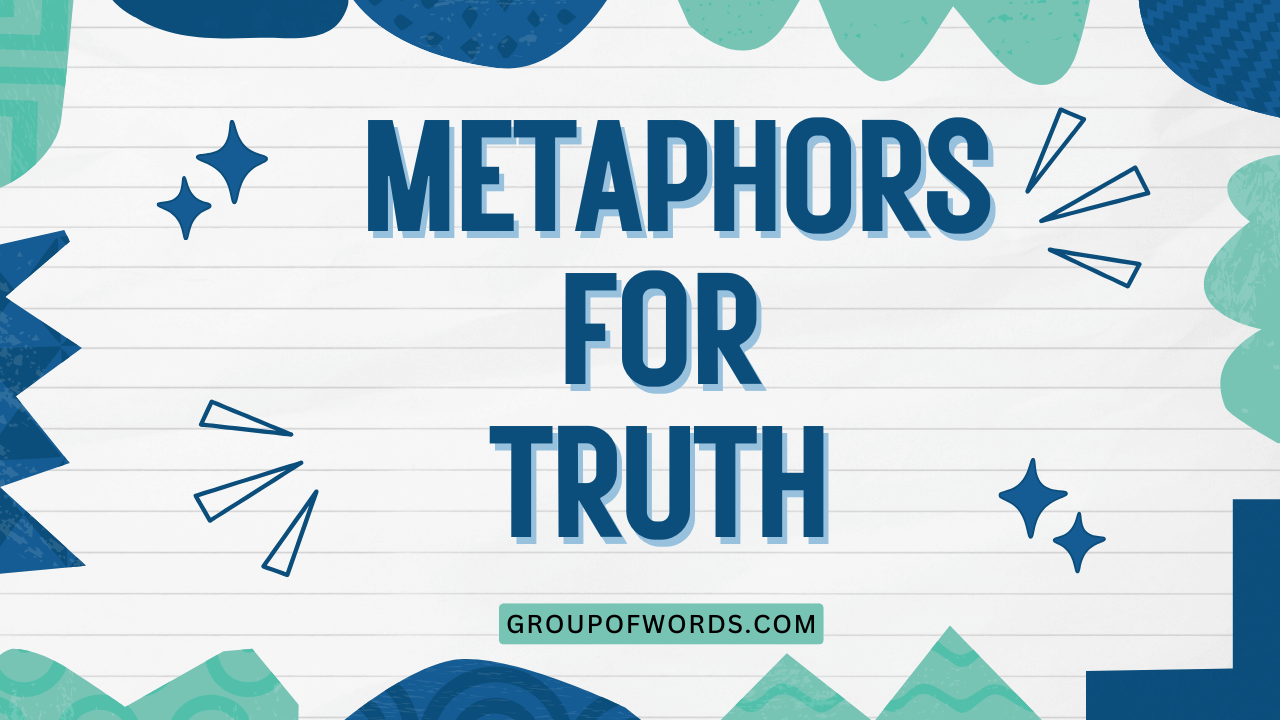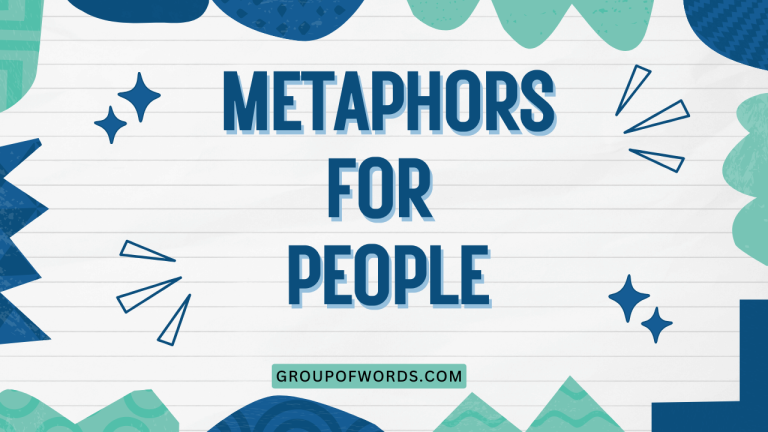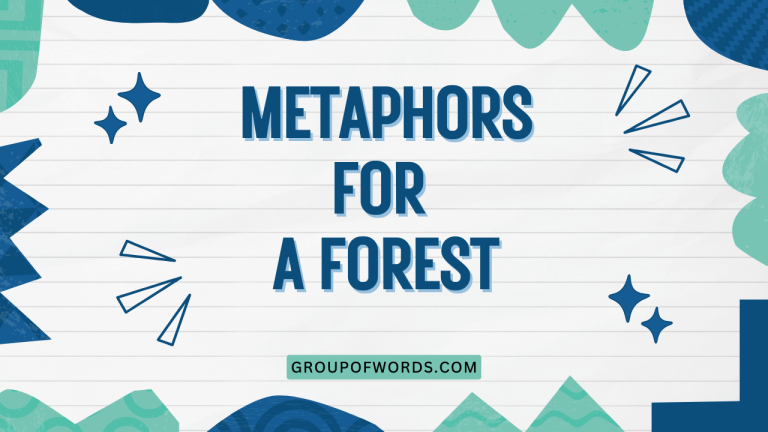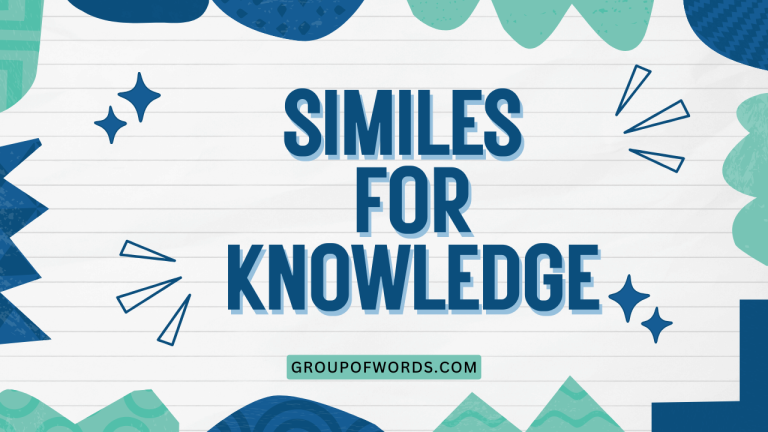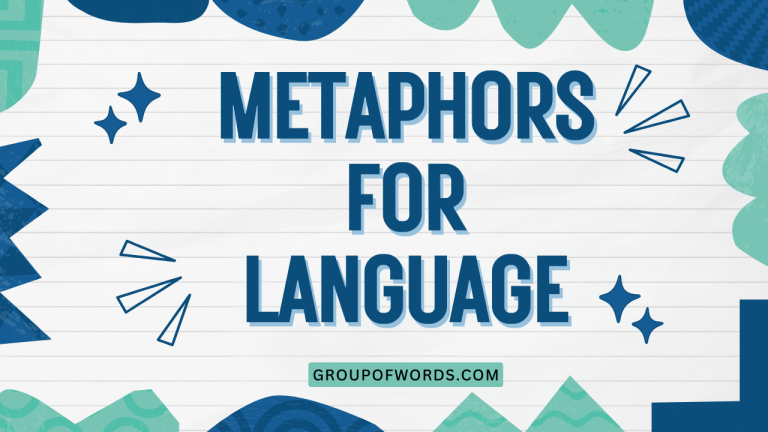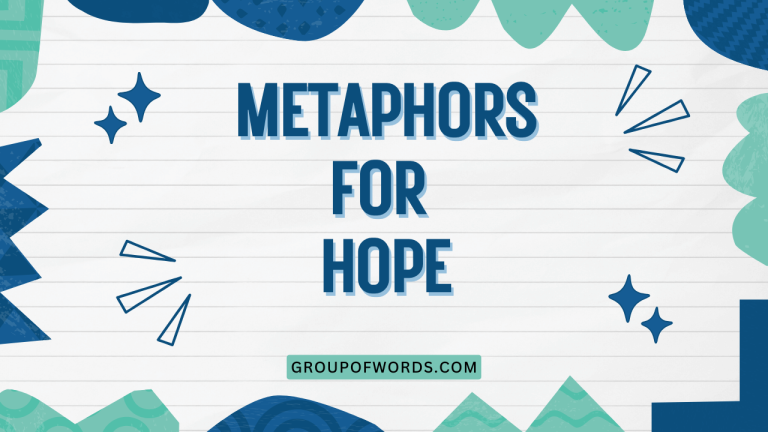Truth Unveiled: Exploring Metaphors for Veracity in English
Understanding how we use metaphors to describe truth is crucial for mastering nuanced communication in English. Metaphors allow us to express abstract concepts like truth in tangible, relatable terms, making our language more vivid and persuasive.
This article delves into the various metaphors used to represent truth, their structural elements, and how to use them effectively. Whether you’re an ESL learner, a student of rhetoric, or simply someone looking to enhance their linguistic skills, this guide will provide you with a comprehensive understanding of this fascinating aspect of English grammar.
Table of Contents
- Introduction
- Definition of Metaphors for Truth
- Structural Breakdown
- Types or Categories of Metaphors for Truth
- Examples of Metaphors for Truth
- Usage Rules for Metaphors for Truth
- Common Mistakes
- Practice Exercises
- Advanced Topics
- FAQ
- Conclusion
Introduction
Metaphors are fundamental to human cognition and communication. They allow us to understand abstract concepts by relating them to more concrete experiences.
When it comes to truth, a concept often debated and difficult to pin down, metaphors become essential tools for expression and comprehension. By exploring the various ways we metaphorically represent truth, we gain a deeper understanding of its multifaceted nature and how it influences our interactions.
This article will guide you through the common metaphors used to depict truth in the English language. We will examine their structural elements, explore different categories, provide numerous examples, and discuss the rules governing their proper usage.
Additionally, we will address common mistakes and provide practice exercises to solidify your understanding. Whether you’re writing an essay, delivering a speech, or simply engaging in everyday conversation, mastering these metaphors will enhance your ability to communicate effectively and persuasively.
Definition of Metaphors for Truth
A metaphor for truth is a figure of speech that uses an image, object, or concept to represent the abstract idea of truth. It involves understanding truth not in its literal sense, but through the lens of something else that shares similar qualities or characteristics.
The purpose of using metaphors for truth is to make the concept more relatable, understandable, and impactful.
Classification: Metaphors for truth fall under the broader category of conceptual metaphors, which are metaphors that structure our understanding of abstract concepts. They are also considered rhetorical devices, used to persuade, engage, and clarify communication.
Function: The primary function of metaphors for truth is to convey the essence of truth in a more vivid and memorable way. They can also be used to emphasize certain aspects of truth, such as its clarity, its power, or its fragility. By employing metaphors, speakers and writers can evoke emotions and create a deeper connection with their audience.
Contexts: Metaphors for truth are used in various contexts, including literature, philosophy, politics, journalism, and everyday conversation. They are particularly prevalent in persuasive writing and speeches, where the goal is to convince the audience of a particular viewpoint. The choice of metaphor can significantly influence how the audience perceives and understands the message being conveyed.
Structural Breakdown
Understanding the structure of metaphors for truth involves recognizing the two key elements: the tenor and the vehicle. The tenor is the subject being described (in this case, truth), and the vehicle is the image, object, or concept used to represent it. The connection between the tenor and the vehicle is based on shared characteristics or qualities.
For example, in the metaphor “Truth is a light,” the tenor is “truth,” and the vehicle is “light.” The shared quality is the ability to illuminate or reveal something. Light reveals what is hidden in darkness, and truth reveals what is hidden by falsehood or ignorance.
The effectiveness of a metaphor depends on the strength of the connection between the tenor and the vehicle, as well as the audience’s ability to understand the connection. A well-chosen metaphor can resonate deeply and create a powerful impact, while a poorly chosen metaphor can be confusing or ineffective.
Another important aspect of metaphorical structure is the implied comparison. Unlike similes, which explicitly state the comparison using words like “like” or “as,” metaphors imply the comparison. This implicit nature can make metaphors more subtle and persuasive.
Consider the metaphor, “Truth is a sturdy bridge.” The comparison between truth and a bridge is not explicitly stated, but it is implied. The metaphor suggests that truth, like a bridge, provides a reliable way to cross over obstacles or connect different points of view.
Understanding these structural elements allows for a deeper appreciation of the art and science of metaphorical language.
Types or Categories of Metaphors for Truth
Metaphors for truth can be categorized based on the specific image, object, or concept used to represent it. Here are some common categories:
Truth as Light
This category uses light as a metaphor for truth, emphasizing its ability to illuminate, reveal, and dispel darkness or ignorance. Light often symbolizes clarity, understanding, and knowledge.
Example: “The truth shone like a beacon in the darkness of deceit.”
Truth as a Path
This category uses a path or journey as a metaphor for truth, highlighting the process of discovering or pursuing truth. It suggests that finding truth can be a long and challenging journey.
Example: “The path to truth is often winding and difficult.”
Truth as a Foundation
This category uses a foundation or structure as a metaphor for truth, emphasizing its stability, reliability, and the idea that it supports other beliefs or ideas. A strong foundation is essential for building something lasting.
Example: “Honesty and integrity are the foundation upon which truth is built.”
Truth as a Weapon
This category uses a weapon as a metaphor for truth, highlighting its power to defend against falsehood, injustice, or oppression. It suggests that truth can be a powerful tool for fighting for what is right.
Example: “The truth is a sword that cuts through lies and deception.”
Truth as a Commodity
This category uses a commodity (something that can be bought or sold) as a metaphor for truth, often highlighting its value, scarcity, or the idea that it can be traded or exchanged. This metaphor can also be used critically to suggest that truth is being manipulated or commercialized.
Example: “In today’s world, truth is a rare and precious commodity.”
Examples of Metaphors for Truth
Here are some examples of metaphors for truth, organized by category. These tables provide specific instances of how these metaphors are used in different contexts.
Each table contains numerous examples illustrating the variety and richness of metaphorical language.
Table 1: Truth as Light
This table illustrates how truth is often portrayed as a source of light, revealing what was previously hidden or obscured. The examples show the versatility of this metaphor in both positive and negative contexts.
| Metaphor | Example Sentence |
|---|---|
| Truth is a beacon | The truth acted as a beacon, guiding him through the fog of misinformation. |
| Truth shines | The truth always shines through, no matter how hard someone tries to hide it. |
| Truth illuminates | Her testimony illuminated the dark corners of the conspiracy. |
| Truth dispels darkness | The truth dispelled the darkness of doubt and fear. |
| Truth is a ray of hope | In the midst of despair, the truth emerged as a ray of hope. |
| Truth’s light | The light of truth exposed the corrupt politician’s lies. |
| Truth emerges from the shadows | After years of secrecy, the truth emerged from the shadows. |
| Truth dawns | The truth finally dawned on him, revealing the extent of the betrayal. |
| Truth is a spotlight | The investigation shone a spotlight on the truth, revealing the company’s fraudulent practices. |
| Truth is a flame | The flame of truth burned brightly, consuming the web of deceit. |
| Truth is a sun | The truth, like the sun, eventually rises and reveals all. |
| Truth is a lantern | He held the lantern of truth high, guiding others to understanding. |
| Truth is a star | The truth, like a distant star, offered a glimmer of hope in the darkness. |
| Truth is a headlight | The headlight of truth cut through the thick fog of propaganda. |
| Truth is a flashlight | She used the flashlight of truth to expose the hidden injustices. |
| Truth casts light | The newly discovered evidence cast light on the previously unsolved mystery. |
| Truth is a bright idea | The truth, like a bright idea, suddenly illuminated his understanding. |
| Truth is radiant | Her radiant truthfulness inspired trust in everyone she met. |
| Truth is a lighthouse | The lighthouse of truth guided the ship of justice safely to shore. |
| Truth is a clear sky | After the storm of lies, the truth emerged like a clear sky. |
| Truth is a mirror | The truth, like a mirror, reflected the reality of the situation. |
| Truth is a window | The truth opened a window into the hidden world of corruption. |
| Truth is a revelation | The truth was a revelation, changing everything he thought he knew. |
| Truth is a spark | A single spark of truth ignited a wildfire of change. |
Table 2: Truth as a Path
This table presents examples of truth being metaphorically represented as a path or journey, emphasizing the process of discovery and the challenges involved in finding it. These metaphors often highlight the perseverance required to reach the destination of truth.
| Metaphor | Example Sentence |
|---|---|
| Truth is a path | The path to truth is often fraught with obstacles and challenges. |
| Truth is a journey | Discovering the truth is a long and arduous journey. |
| Truth is a road | The road to truth is paved with good intentions, but also with difficult decisions. |
| Truth is a winding road | The winding road to truth often leads through unexpected places. |
| Truth is a difficult path to tread | Speaking the truth can be a difficult path to tread, especially when it’s unpopular. |
| Truth is a trail | The trail of truth led them to the hidden treasure. |
| Truth is a route | The route to truth requires careful navigation and critical thinking. |
| Truth is a course | The course to truth is not always straightforward. |
| Truth is a pilgrimage | His quest for truth was a spiritual pilgrimage. |
| Truth is a quest | The quest for truth drove him to explore the unknown. |
| Truth is a voyage | The voyage to truth can be turbulent and unpredictable. |
| Truth is a trek | The trek to truth required courage and determination. |
| Truth is a labyrinth | The labyrinth of truth was filled with dead ends and false leads. |
| Truth is a maze | Navigating the maze of truth required patience and persistence. |
| Truth is a climb | The climb to truth was steep and challenging. |
| Truth is a search | The search for truth led him to question everything he knew. |
| Truth is an exploration | The exploration of truth revealed new perspectives and possibilities. |
| Truth is a mission | His mission for truth was driven by a deep sense of justice. |
| Truth is a pursuit | The pursuit of truth is a lifelong endeavor. |
| Truth is a scavenger hunt | The scavenger hunt for truth led them to uncover hidden clues. |
| Truth is a race | The race to truth was won by those who were most persistent. |
| Truth is a marathon | The marathon of truth required endurance and unwavering commitment. |
| Truth is a long walk | The long walk to truth tested his resolve and determination. |
| Truth is a highway | The highway to truth was well-traveled by those seeking knowledge. |
Table 3: Truth as a Foundation
This table illustrates how truth is often seen as a fundamental base upon which other things are built. The metaphors in this table highlight the importance of truth for stability, reliability, and lasting impact.
| Metaphor | Example Sentence |
|---|---|
| Truth is a foundation | Truth is the solid foundation upon which trust is built. |
| Truth is a cornerstone | Honesty is the cornerstone of any successful relationship. |
| Truth is a bedrock | Integrity is the bedrock of a just society. |
| Truth is a base | Truth is the essential base for all meaningful progress. |
| Truth is a pillar | Justice is a pillar of a democratic society, supported by truth. |
| Truth is a groundwork | The groundwork of truth must be laid before any structure can be built. |
| Truth is a support | Truth is the unwavering support upon which we can rely. |
| Truth is an anchor | Truth is the anchor that keeps us grounded in reality. |
| Truth is a root | Truth is the deep root that nourishes understanding. |
| Truth is a framework | Truth provides the framework for ethical decision-making. |
| Truth is a infrastructure | A reliable infrastructure of truth is required for a healthy democracy. |
| Truth is a skeleton | Truth forms the skeleton of any credible argument. |
| Truth is a backbone | Truth is the backbone of a strong moral compass. |
| Truth is a scaffold | Truth is the scaffold upon which we build our knowledge. |
| Truth is a building block | Each piece of truth is a building block in the construction of understanding. |
| Truth is a platform | Truth provides a platform for open and honest dialogue. |
| Truth is a launching pad | Truth is the launching pad for innovative ideas and solutions. |
| Truth is an underpinning | Truth is the essential underpinning of a stable society. |
| Truth is a foundation stone | The foundation stone of their relationship was built on trust and honesty. |
| Truth is a substructure | The substructure of their argument was based on solid evidence and truthful data. |
Table 4: Truth as a Weapon
This table demonstrates how truth can be portrayed as a weapon or tool used to combat falsehood, injustice, or oppression. These metaphors emphasize the power and effectiveness of truth in overcoming challenges.
| Metaphor | Example Sentence |
|---|---|
| Truth is a sword | The truth is a sword that cuts through lies and deception. |
| Truth is a shield | Truth is a shield against the arrows of misinformation. |
| Truth is a weapon | Armed with the truth, they fought against injustice. |
| Truth is an arsenal | The library was an arsenal of truth, ready to be used in the battle against ignorance. |
| Truth is a tool | The truth is a powerful tool for achieving justice. |
| Truth is a hammer | The hammer of truth shattered the wall of silence. |
| Truth is a lance | The lance of truth pierced the heart of the conspiracy. |
| Truth is a bomb | The truth exploded, revealing the shocking secrets. |
| Truth is a grenade | The grenade of truth detonated, shattering the illusion of peace. |
| Truth is a bullet | The bullet of truth struck at the core of the deception. |
| Truth is a missile | The missile of truth targeted the heart of the problem, destroying the corrupt system. |
| Truth is a knife | The knife of truth cut through the layers of deceit. |
| Truth is a scalpel | The scalpel of truth surgically removed the tumor of corruption. |
| Truth is a flame thrower | The truth was a flame thrower, burning away the falsehoods. |
| Truth is a cannon | The cannon of truth fired, demolishing the fortress of lies. |
| Truth is a wrecking ball | The wrecking ball of truth demolished the structures of deceit. |
| Truth is a laser | The laser of truth precisely targeted the source of the problem. |
| Truth is a sledgehammer | The sledgehammer of truth smashed the barriers of ignorance. |
| Truth is a crowbar | The crowbar of truth pried open the secrets that had been hidden for years. |
| Truth is a drill | The drill of truth bored deep into the layers of misinformation. |
Table 5: Truth as a Commodity
This table explores metaphors that depict truth as a commodity, something that can be bought, sold, or traded. These metaphors often carry a critical tone, suggesting that truth is being manipulated or commercialized for profit or gain.
| Metaphor | Example Sentence |
|---|---|
| Truth is a commodity | In today’s media landscape, truth is often treated as a commodity to be bought and sold. |
| Truth is currency | In politics, truth is often used as currency to gain power and influence. |
| Truth is a resource | Truth is a valuable resource that should be protected and shared. |
| Truth is a product | The news industry often presents truth as a product to be consumed by the public. |
| Truth is a trade | Politicians often engage in a trade of truths to achieve their objectives. |
| Truth is a bargain | The search for truth should not be a bargain, but a commitment to uncovering facts. |
| Truth is a prize | The truth is a prize that is worth fighting for. |
| Truth is a jewel | Truth is a rare jewel, highly valued and often difficult to find. |
| Truth is a treasure | The truth is a treasure worth more than gold. |
| Truth is a luxury | In some societies, the truth is a luxury that few can afford. |
| Truth is a market | The market for truth is often flooded with misinformation and propaganda. |
| Truth is a trade secret | The company guarded the truth like a trade secret, protecting its competitive advantage. |
| Truth is a valuable asset | Truth is a valuable asset for any organization seeking to build trust and credibility. |
| Truth is a bargaining chip | Truth was used as a bargaining chip in the negotiations. |
| Truth is a hot commodity | The truth about the scandal was a hot commodity in the media. |
| Truth is a limited resource | Truth is a limited resource, often overshadowed by misinformation. |
| Truth is a rare find | The truth about what happened that night was a rare find. |
| Truth is a debt | He felt like he owed the world the truth, as if it were a debt to be repaid. |
| Truth is a dividend | Investing in truth yields dividends in the form of trust and understanding. |
| Truth is a gain | By revealing the truth, the company hoped to gain back the trust of its customers. |
Usage Rules for Metaphors for Truth
Using metaphors for truth effectively requires careful consideration of several factors. Here are some key usage rules:
- Clarity: The metaphor should be clear and easily understood by the audience. Avoid metaphors that are too obscure or complex.
- Relevance: The metaphor should be relevant to the context and the message being conveyed. The connection between the tenor (truth) and the vehicle (the image or object) should be logical and meaningful.
- Consistency: Maintain consistency in the use of the metaphor throughout your communication. Avoid mixing metaphors or shifting between different metaphorical representations of truth.
- Originality: While common metaphors can be effective, consider using original or less common metaphors to create a greater impact and engage the audience more deeply.
- Appropriateness: Choose metaphors that are appropriate for the audience and the situation. Consider the cultural background, knowledge level, and emotional state of the audience.
- Avoid Clichés: Steer clear of overused or clichéd metaphors, as they can sound stale and uninspired. Instead, aim for fresh and imaginative comparisons.
- Consider the Connotations: Be mindful of the connotations associated with the vehicle of your metaphor. Ensure that the connotations align with the message you are trying to convey about truth.
Common Mistakes
Here are some common mistakes to avoid when using metaphors for truth:
| Mistake | Incorrect Example | Correct Example |
|---|---|---|
| Mixed Metaphor | “The truth is a beacon that lays the foundation for success.” | “The truth is a beacon that guides us through the darkness.” |
| Clichéd Metaphor | “The truth will come out in the wash.” | “The truth emerged slowly, like a plant pushing through concrete.” |
| Inappropriate Metaphor | “Truth is a nuclear bomb that destroys everything in its path.” (In most contexts, this is too aggressive.) | “Truth is a powerful tool that can dismantle injustice.” |
| Unclear Metaphor | “The truth is a quantum entanglement.” | “The truth is a complex web of interconnected facts.” |
Practice Exercises
Test your understanding of metaphors for truth with these practice exercises.
Exercise 1: Identifying Metaphors
Identify the metaphor for truth in each of the following sentences:
| Question | Answer |
|---|---|
| 1. The truth is a sturdy bridge that connects different perspectives. | Truth is a sturdy bridge |
| 2. Her words were a beacon of truth in a sea of lies. | Beacon of truth |
| 3. The path to truth is often filled with obstacles and challenges. | Path to truth |
| 4. The truth is a sword that cuts through deception. | Truth is a sword |
| 5. In politics, truth is often a rare and precious commodity. | Truth is a rare and precious commodity |
| 6. The truth is a compass, guiding us toward what is right. | Truth is a compass |
| 7. The truth is a map, showing us the way forward. | Truth is a map |
| 8. The truth is a key, unlocking hidden understanding. | Truth is a key |
| 9. The truth is a mirror, reflecting reality back at us. | Truth is a mirror |
| 10. The truth is a light switch, it turns on and you can see. | Truth is a light switch |
Exercise 2: Completing Metaphors
Complete the following sentences by adding a metaphor for truth:
| Question | Answer |
|---|---|
| 1. The truth is like a ______, revealing what was hidden. | The truth is like a spotlight, revealing what was hidden. |
| 2. Finding the truth is a long ______, filled with twists and turns. | Finding the truth is a long journey, filled with twists and turns. |
| 3. Honesty is the ______ upon which strong relationships are built. | Honesty is the foundation upon which strong relationships are built. |
| 4. The truth can be a powerful ______, used to fight injustice. | The truth can be a powerful weapon, used to fight injustice. |
| 5. In a world of misinformation, truth is a ______ that must be protected. | In a world of misinformation, truth is a treasure that must be protected. |
| 6. The truth is a guiding ______ that keeps us on course. | The truth is a guiding star that keeps us on course. |
| 7. The truth is a ______ that helps us see things clearly. | The truth is a lens that helps us see things clearly. |
| 8. The truth is a ______ that can heal wounds. | The truth is a balm that can heal wounds. |
| 9. The truth is a ______ that can set us free. | The truth is a liberator that can set us free. |
| 10. The truth is a ______ that can connect us all. | The truth is a common ground that can connect us all. |
Exercise 3: Creating Metaphors
Create your own metaphors for truth based on the following categories:
| Category | Your Metaphor |
|---|---|
| Truth as Nature | The truth is like a seed; small at first, but with the potential to grow into something strong and substantial. |
| Truth as Art | The truth is like a mosaic; composed of many small pieces that, when put together, create a beautiful and complete picture. |
| Truth as Science | The truth is like an experiment; constantly tested and refined to ensure its accuracy and validity. |
| Truth as Music | The truth is like a symphony; a harmonious arrangement of different voices and perspectives that create a rich and complex sound. |
| Truth as Food | The truth is like nourishment, feeding the mind and soul with understanding and insight. |
Advanced Topics
For advanced learners, consider exploring the following topics:
- Conceptual Metaphor Theory: Delve deeper into the theory that our conceptual system is fundamentally metaphorical.
- Cross-Cultural Metaphors for Truth: Investigate how different cultures use different metaphors to represent truth, reflecting their unique values and beliefs.
- The Role of Metaphors in Political Discourse: Analyze how politicians use metaphors to shape public opinion and influence policy decisions.
- The Ethics of Using Metaphors for Truth: Consider the ethical implications of using metaphors to persuade or manipulate others, especially when dealing with sensitive or complex issues.
FAQ
Here are some frequently asked questions about metaphors for truth:
- What is the difference between a metaphor and a simile?
A metaphor implies a comparison between two unlike things, stating that one thing is another. A simile, on the other hand, explicitly states the comparison using words like “like” or “as.” For example, “Truth is a light” is a metaphor, while “Truth is like a light” is a simile.
- Why are metaphors for truth important?
Metaphors for truth are important because they help us understand and communicate abstract concepts in a more relatable and impactful way. They can also evoke emotions and create a deeper connection with the audience.
- How can I improve my ability to use metaphors for truth?
To improve your ability to use metaphors for truth, practice identifying and analyzing metaphors in literature, speeches, and everyday conversation. Experiment with creating your own metaphors and seek feedback from others. Also, broaden your knowledge of different subjects and experiences, as this will provide you with a wider range of potential vehicles for your metaphors.
- What are some common pitfalls to avoid when using metaphors for truth?
Some common pitfalls to avoid include using mixed metaphors, clichéd metaphors, inappropriate metaphors, and unclear metaphors. Always strive for clarity, relevance, consistency, and originality in your use of metaphorical language.
- Can metaphors for truth be used to mislead or manipulate?
Yes, metaphors for truth can be used to mislead or manipulate, especially when they are used to oversimplify complex issues or to evoke strong emotions without providing factual support. It is important to be aware of the potential for misuse and to critically evaluate the metaphors used by others.
- How do cultural differences affect the interpretation of metaphors for truth?
Cultural differences can significantly affect the interpretation of metaphors for truth, as different cultures may have different associations with the images, objects, or concepts used as vehicles. It is important to be aware of these cultural differences and to choose metaphors that are appropriate for the target audience.
- Are some metaphors for truth more effective than others?
Yes, some metaphors for truth are more effective than others, depending on the context, the audience, and the message being conveyed. The most effective metaphors are those that are clear, relevant, consistent, original, and appropriate.
- How can I use metaphors for truth in my writing?
To use metaphors for truth effectively in your writing, start by identifying the key ideas you want to convey about truth. Then, brainstorm different images, objects, or concepts that share similar qualities or characteristics. Choose the metaphor that best captures the essence of your message and use it consistently throughout your writing.
Conclusion
Metaphors for truth are powerful tools that can enhance our understanding and communication of this complex concept. By understanding the different categories of metaphors, their structural elements, and the rules governing their proper usage, you can effectively employ them in your writing, speaking, and everyday interactions.
Avoiding common mistakes and practicing regularly will further refine your skills and allow you to communicate with greater clarity and impact.
